#Howard Scott Warshaw
Explore tagged Tumblr posts
Video
youtube
Once Upon Atari Howard Scott Warshaw
#youtube#Howard Scott Warshaw#Atari#Retro Gamer#video games#et the extra terrestrial#yars revenge#Once Upon Atari
0 notes
Text
Game Spotlight #17: Telenet Music Box (1989)

Acquired Stardust is back with another spotlight! Need something to read to get your mind of recent world events? Been hunting for some new music to listen to? Do you just like learning about cool obscure stuff? Join Ash for a look at one of the most obscure things as of yet featured on the blog in 1989's Telenet Music Box for the PC88!
When thinking about the history of video games, many people of a certain age conjure to mind a beginning marked by the boom that Nintendo's NES (known in Japan as the Famicom) brought to the world. Fewer people will be overly familiar with Atari's platforms or their competitors, and fewer still will likely have heard about the infamous crash of the American video game industry in 1983 beyond being able to regurgitate myths of Howard Scott Warshaw's adaptation of E.T. the Extraterrestrial (1983) bearing supposed direct responsibility.
This pop history approach becoming so normalized to people is frustrating but understandable because it's all around us. Being inundated with countless YouTubers and streamers professing a love for retro games has inadvertently created a narrative that video game history is a straight line through mainstream smash hit consoles and this couldn't be further from the truth - there is a whole world before and around the NES that has gone largely unexplored, particularly in the west, and odds are if you've spent much time on Tumblr you're probably passingly familiar with the subject of this spotlight.
Japan has finally begun to more widely adopt PC gaming (in part due to the phenomenon that is vtubing), with an absolute explosion in market share in the past decade. What you might not know is that Japan actually has a pretty rich history of PC gaming that really blossomed in the 80s and 90s with several hardware manufacturers such as NEC and ASCII offering options that would give the world some early looks at teams and individuals that would come to define the medium going forward.
One such game changer (no pun intended) is Hideo Kojima's Metal Gear debuting in 1987 with its definitive version on MSX PCs and getting an incredible sequel that puts the NES-exclusive Snake's Revenge to shame, and another Kojima title would go on to define the NEC PC98 in popular consciousness with classic sexy adventure Policenauts easily being the most memorable title which would subsequently be ported and updated several times for home consoles such as the Sega Saturn and Sony Playstation.
You may be familiar with the PC98 as screenshots from its many games are popular around Tumblr, most often featuring gloriously mid-late 90s anime girls rendered in stunning pixel art that feels like it exists somewhere out of time as things isolated from their origin as video game screenshots. Having been on Tumblr for over a decade (and the internet at large for even longer), it's my observation that the rediscovery of and appreciation for this retro anime aesthetic (and its later PC98 permutation) was really born here on Tumblr before spreading to other platforms to the point that you've probably seen at least one shot cross your dashboard before. But for this spotlight we're going even further back to the predecessor of the PC98, the PC88.

NEC's PC88 was released in the early 80s and most models featured a whopping 62 KB of RAM (in comparison to the NES's 2 KB) and many later models featured Yamaha sound chips which resulted in games often being visually and aurally significantly more impressive than you would see in home consoles at the time, in some cases lightyears ahead of the NES particularly in regards to music which is a pretty great thing for the sake of this spotlight. The games themselves were also quite varied in content from everything to the kawaii and comedic to erotic and even plenty of horror, with many standout games more accurately reflecting wider Japanese pop culture of the era than what you'd see on the comparatively sterile NES.
This wild west, edgy punk rock software library that goes part and parcel with Japan's nascent PC gaming scene is one of the coolest elements of going back to explore it. You never really know what you're in for, and you might be surprised (or even disgusted) with some of the unique experiences the platform has to offer. Many of these games (and those on the successor PC98) are completely untranslated and Japanese comprehension helps their enjoyment greatly and while often simple enough to enjoy without it that aspect has certainly contributed to their enigma in the west.
There are a lot of factors that have made PC88 and PC98 fandom and emulation not as glamorous as that of home consoles and some of that is due to limitations of the hardware in how it handles scrolling screens, with a noticeable chug as games scroll. Another factor is the compounding nature of its flaws and obscurity meaning emulators themselves are in Japanese and a bit tricky to figure out how to handle, old PCs infamously lacking a lot of user friendly features we take for granted today.
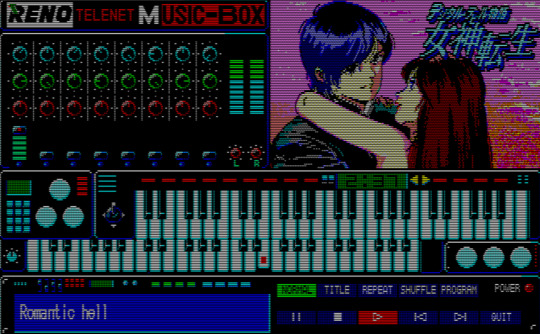
One such surprise is Telenet Music Box, a collection of then-prominent publisher Telenet Japan's biggest games' music. It's barely even a game and more a piece of software fit for a museum, with minimal activity limited to browsing game albums (a total of 13), choosing songs to listen to and creating custom playlists. Each of the 13 game albums is showcased with beautiful splash art and accompanied by a tracker for the keyboard as well as titles for each song and a timer for the length of songs.
Included in the mix is an impressive slate of Telenet Japan's games that showcase the depth and variety of the PC88's library such as Mugen Senshi Valis and even an early alternate manifestation of Shin Megami Tensei as a top-down dungeon crawler reminiscent of Gauntlet. Each of Telenet Music Box's 13 albums have their standout tracks, with some from Luxor and Final Zone being among our favorites.
Telenet Music Box is not a wholly unique concept and several other similar games were released for the platform (as well as the PC98), but it is an exceptionally clever one who's usefulness is perhaps all the more apparent now almost 40 years removed from its release, serving as a fantastic introductory course to a little understood part of video game history. It's a fantastic time capsule and with plenty to offer listeners of its roughly 3 hour runtime well beyond its value as virtual archaeology worth excavating.
Perhaps its most valuable asset is its ability to highlight the true nature of history. History is not a static thing with a start and an end but rather a living breathing thing that touches our everyday lives. Rare is it that anything begins or ends from nothing, with things instead in a constant state of evolution even when rising from the ashes of something else. One particular example of this is in Wolf Team's Final Zone (which features hilarious commentary in its opening scene that I'm not sure how made it past management - do look it up if you can) and Mugen Senshi Valis, the latter of which having been extremely popular in its time, spawning tons of ports and several sequels, with the team behind it eventually morphing into Namco's Tales Studio, responsible for some of the most beloved JRPGs of all time such as Tales of Symphonia and Tales of Vesperia.
While PC88 emulation can be frustrating to work out or find files for, an unforeseen strength of Telenet Music Box's concept of 'game as an album' is how much easier its discoverability is in recent years compared to the more traditional video games it shares a platform with, being far more easy to interface with and experience than the games it itself chronicles, and it can be found on YouTube in its entirety for your listening pleasure alongside plenty of other PC88 soundtracks. I invite you to dip your toes into this little-known scene and hope you come out of it with appreciation for the wide world of games outside what may be familiar to you, and maybe even some new favorite tracks.
A gem hidden among the stones, Telenet Music Box is undoubtedly stardust.
- Ash
#gaming#retro gaming#video games#games writing#written posts#game spotlights#games blogging#long reads#video games writing#essay#writing about games#games journalism#game review#game recommendations#obscure games#telenet#telenet japan#telenet music box#80s#pc88#game music#vgm#chiptune#1980s#heisei era#showa era#showa retro#heisei retro#pixel art
86 notes
·
View notes
Text

Reminder that E.T. for Atari is not, in fact, a story about how a game was so bad it crashed a market. It's a story about how crunch time ruined the career of a talented developer.
#.txt#game industry#video games#gaming#E.T.#atari#this industry DESPERATELY needs regulation and has for decades
10 notes
·
View notes
Text
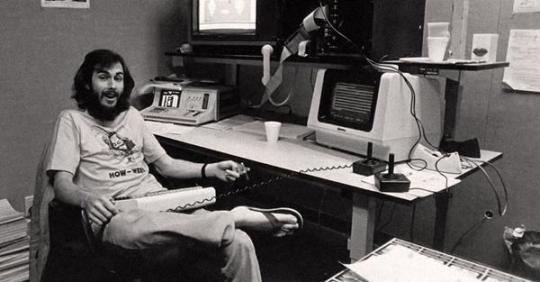
Howard Scott Warshaw, Atari ET developer. 1982.
35 notes
·
View notes
Text
the books I read in 2023
Welp, time to finally face this post and submit it. I'm kind of embarrassed because I am so bad at reading anymore. No explanation, no excuses. I used to read twice this many books as a matter of course, and now I ... like, don't. My TBR barely budged ... I cleared some stuff out thanks to summer camp, but then I got new stuff to fill it back up.
I don't know. Maybe one day I'll start reading again. Not today, though, probably. This year's list has two books on it so far, both of which I'm maybe a quarter into. Ugh.
Wired Style, Constance Hale & Jessie Scanlon
Once Upon Atari, Howard Scott Warshaw
Dragonwatch: Master of the Phantom Isle, Brandon Mull
The Illustrated Al, ed. Josh Bernstein
Fucking Apostrophes, Simon Griffin
Jazz in the Bittersweet Blues of Life, Wynton Marsalis and Carl Vigeland
The Kitchen Detective, Christopher Kimball
Decoding Boys, Cara Natterson
The Maxx (1-35, complete), Sam Kieth (1)
Bury My Heart at Chuck E. Cheese’s, Tiffany Midge
Barely Functional Adult, Meichi Ng
What If? 2, Randall Munroe
8 Simple Rules for Dating My Teenage Daughter, W. Bruce Cameron (2)
Over Sea, Under Stone, Susan Cooper
This Mournable Body, Tsitsi Dangarembga
The Goldfinch, Donna Tartt
The Rapture of the Nerds, Cory Doctorow and Charles Stross
The New Hacker’s Dictionary, ed. Eric S. Raymond (3)
All You Need is Kill, Hiroshi Sakurazaka
Wind/Pinball, Haruki Murakami
Disappearing Earth, Julia Phillips
Where Nobody Knows Your Name, John Feinstein
We Should Hang Out Sometime, Josh Sundquist
Watchmen, Alan Moore and Dave Gibbons
The Philosophy of Modern Song, Bob Dylan
Guardians of the Galaxy: The Complete Collection, Dan Abnett & Andy Lanning, et al.
The Dark is Rising, Susan Cooper (4)
Banana Ball, Jesse Cole
A Love Supreme: The Story of John Coltrane’s Signature Album, Ashley Kahn
Free Lunch, Rex Ogle (5)
Greenwitch, Susan Cooper (6)
The Shepherd, the Angel, and Walter the Christmas Miracle Dog, Dave Barry
italics: read it before bold: read it to my kid in bed struck: unfinished
I’d read the first ten or so issues of this before, out of interest because I watched the animated series on MTV. This is the first time all the way through and I didn’t realize it was so dark and triggering.
I read this one when mine was a toddler, and remembered it being pretty patriarchal and victorian. Thought maybe it would hit different now that she’s actually teenaged, and ... like, it did! it’s even worse! Absolutely zero of this shit fits a kid who is not 100% straight and searching. I got through four essays and took it back to the library.
I got up through the Bs and then I LOST MY COPY.
The more I read of this, the more I realized I maybe only read the first couple chapters. Still keeping the italics (making up for claiming I never previously read The Maxx).
I subbed a middle school reading class where this was the text. Ended up reading the whole thing across the day.
This could be the last new book I ever read to my own children. We generally don't read to sleep during holiday breaks, instead allowing them to fall asleep in front of a TV. But when school restarted, my youngest (officially a teenager) didn't want me to read to him at bedtime anymore. The end of an era. I may have cried a little bit. I expect the Dave Barry on Christmas Eve tradition to continue at least another year (my oldest likes it and specifically requested it again), but maybe no more new ones.
0 notes
Photo


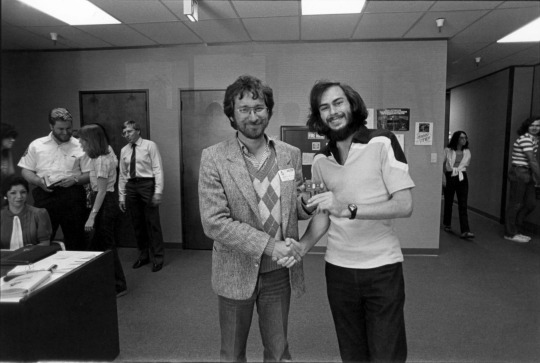
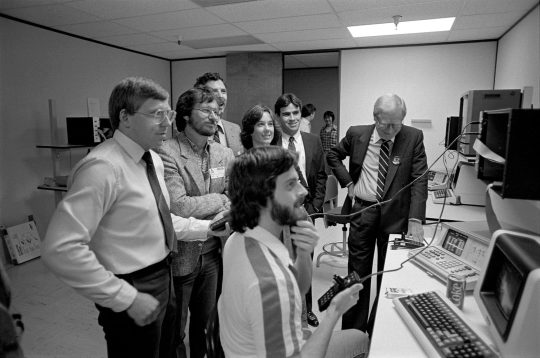
Howard Scott Warshaw working on E.T. the extra-terrestrial for Atari 2600 (1982)
#howard scott warshaw#steven spielberg#e.t. the extra terrestrial#atari#2600#retrogaming#1980s#80s#80's#1982
237 notes
·
View notes
Photo
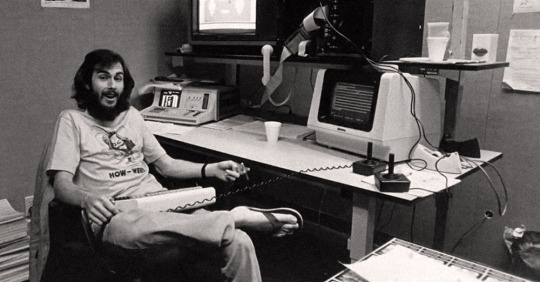
Atari programmer Howard Scott Warshaw. He created the best selling Atari 2600 game ever. That was Yars Revenge. He also created one of the worst games in history and almost tanked an entire industry. That was E.T.
📸 source: Den Of Geek
3 notes
·
View notes
Text
I realized something the other day. One of the prime complaints about Kingdom of the Crystal Skull was that aliens didn’t fit the Indiana Jones mythos. However Indy’s been running into aliens as far back as the 1982 Atari 2600 Video Game adaptation of Raiders of the Lost Ark, where he could encounter a YAR from YARS’ Revenge:

So aliens have been in the franchise since damn near the beginning.
#Indiana Jones#Raiders of the Lost Ark#Atari 2600#Video Game Adaptation#Aliens#Yars' Revenge#Easter Egg#Howard Scott Warshaw#Yes I know that the YARS technically originated from Earth
8 notes
·
View notes
Photo










Cleaning up some space on my desktop, and thought I’d throw these guys and their works-in-progress pictures up on my Tumblr page for the first time. They were part of a giclee print series I did back in 2011 on my first cintiq. Memories...
5 notes
·
View notes
Text
# 2,904

Kids Stuff label Atari’s Yars’ Revenge (1982)
The second of three 12″ kids records based on Atari’s video games, this time for Yars’ Revenge. Coded / initialed by Howard Scott Warshaw and tributed to then-CEO Ray Kassar, Yars’ Revenge would be the best-selling first-party title for the 2600, and one of the few which a vast majority of female gamers enjoyed.
According to this record: in the closing moments of the 20th Century, us humans took off and ventured through space to explore and colonize the galaxy. (This really happened? Sorry, Elon.) Somehow, our explorers managed to seal themselves with some houseflies that accompanied them on their journey. They say hello to a force-field, fly head-on to meet their destruction, and all perish...except for the flies. The flies mutated with human DNA during the explosion and evolved into human-insect breeds which traversed all throughout time and space to create entire planet civilizations of peace, which I can’t say about our selfish people.
Of course, the opposing Qotiles believe that no one can’t have nice things and partially destroy the Yar civilization. Certainly, the Yars urge to exact revenge, tit for tat. Luckily for us (I say this loosely), not before they belt out their war cry which sounds like a absurdly poor rendition of Kraftwerk’s “Pocket Calculator” (Ralf and Florian had absolutely nothing to do with this, I swear) segueing into some AOR soft-rock vocal treatment that should’ve preferably left forgotten. But, sign of the times for 1982, I guess.
But one thing the Kids Stuff records got right, like they did with Missile Command, was how faithful the stories were aligned to the actual 2600 game play and they were thorough with it. Peck at the force field, create your missile, align yourself against the Qotile cannon, leave the neutral zone, shoot your shot, and get the fuck out of the way of yours and the Qotile swirl. Some Yars get shot down by the enemy, and one shot himself down and got fucked. But soon enough, one of the Yars did it right the fourth time and destroyed the enemy forces. Mission accomplished. At least the ones that went down in battle wouldn’t go back and hear the atrocious dialogue of that family sending their son away to do battle. Another thing they got right? Including actual sound effects and packaging of the original home version, too.
And to think, this story would have never happened if only the journeying crew brought a can of Super Timor with them.
#omega#WUSB#music#mixtapes#reviews#playlists#Kids Stuff#gaming#Atari#Yars Revenge#Ray Kassar#Howard Scott Warshaw#fantasy#Kraftwerk#metal#insects#orange#yellow#red#green#Super Timor
1 note
·
View note
Photo

Retro Game Spotlight 033: Yars' Revenge (1982)
Publisher: Atari Platform: Atari 2600 Designer: Howard Scott Warshaw Box Art: Hiro Kimura
Trivia: Both the neutral zone in the middle of the screen and the explosion between rounds is created on-screen by reusing random bits of the game's code.
#Atari#Atari 2600#Yars' Revenge#video games#retro gaming#Howard Scott Warshaw#box art#Hiro Kimura#Retro Game Spotlight
72 notes
·
View notes
Text
I will be at Freeplay Florida November 19th!!!
I will be at Freeplay Florida November 19th!!!
Hey Arcaders! I’m going to be at Freeplay Florida on November 19th! This will be my first time at the event- and I’m stoked!! What’s a Freeplay Florida you ask? It’s awesome- that’s what it is! If you love the arcades of old, as well as the classic arcade games you used to play (or still do) this is the place to be! From their site- Step back to a time when friends gathered together for games,…
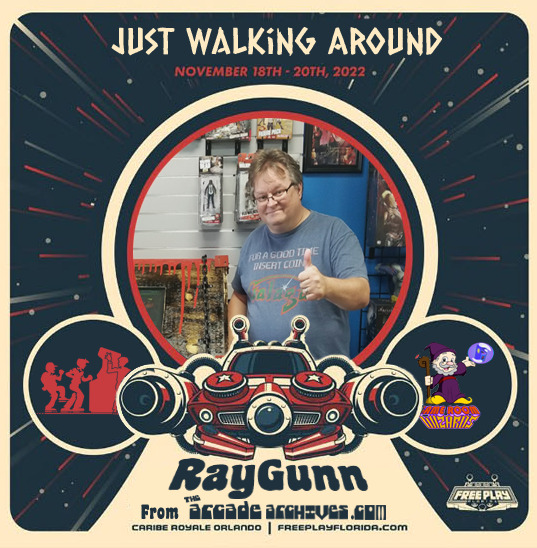
View On WordPress
#1980s Arcades#Arcade Archives#Arcade Archives Network#Freeplay Florida#Howard Scott Warshaw#Warren Davis
0 notes
Text

Yars Revenge isn’t just an Atari 2600 game. It’s a tribute to a tragic space love story set in the Star Trek: The Next Generation universe. *Spoilers ahead*

Lieutenant Yar was the Security Chief on the USS Enterprise. Being she was in charge of security, she often got beamed down to planets to deal with hostile situations.
In the episode “Skin of Evil” Lt. Yar was apart of an away team sent down to desolate planet “Vagra ll” to investigate a distress call from a shuttle returning from a conference.

While on the planet, they encounter a sludge-monster named “Armus” who wants to hurt people for fun...pretty much.
Armus displays it’s power by killing Lt. Yar in one whack. The crew eventually pick up their stranded crewmembers and leave Armus behind and buzz off to the next adventure but not before giving Lt. Yar a proper funeral on the holodeck.


Lt. Yar’s death has somewhat of an “emotional” impact on Lieutenant Commander Data. I say somewhat because Data is an android, incapable of emotions. While Data can’t possibly be “emotional” about her death, he is..erm disappointed that she is gone? Explaining robot emotions are tough.
The reason for his fondness of her, is because they were “intimate” in an earlier episode where everyone on the Enterprise gets some weird space-virus that makes everyone drunk and she banged Data because she needed a “gentle” touch.
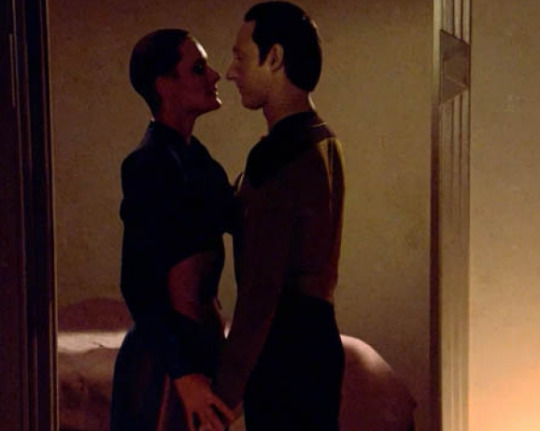
Yeah.
Data carries around a holographic picture of Lt. Yar from here on, as shown in the episode “The Measure of a Man”. He explains that he keeps the picture because Yar was special to him due to the intimacy they shared.
So it’s established that while Data can’t actually “love”, he loved Lieutenant Yar. Furthering Data’s character progression of understanding and becoming more human.
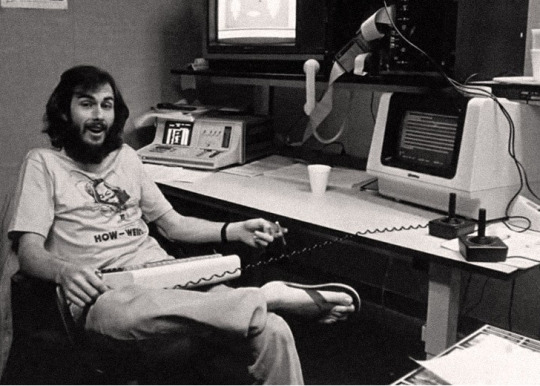
Howard Scott Warshaw, a young game designer at Atari is doing some work around the Atari offices late one night, when he accidentally programs a technological wormhole that allows him to see ten years into the future (Star Trek: TNG began airing in 1987)
Fascinated by Star Trek TNG, He marathons the first three seasons in secret and gets emotionally invested in Lt. Yar and Lt. Comm. Data’s love story.
Atari gets mad at Mr. Warshaw for piddling around the offices so they give him an ultimatum: Either he gets off his ass and makes a successful video game, or he can go work at Chuck E. Cheese.
HSW dug into his heart and decided to make Yars’ (or more appropriately Yar’s) Revenge. He had to alter the material to keep from pissing off the suits at Paramount over ripping off their Star Trek trademark, and to keep people from finding out about his technological wormhole that allows access to future television.
He made up some bull about bugs in space but deep down HSW’s vision of Yar’s Revenge was a playable fanfiction, where Data goes rogue, takes off in a shuttlecraft away from the enterprise and goes back to Vagra ll to blow up the planet that housed the foul bastard that took the only thing that made Data feel truly human. In tribute to his lost love, he named the shuttlecraft “Yar’s Revenge”.

Just use your imagination here, you can totally see it.
Yar’s Revenge went on to be the best selling Atari 2600 game, making Howard Scott Warshaw a rockstar in the world of video games. He went on to design the famous Atari flop “E.T” and left the business shortly after. Being content with the pile of money he made from Yar’s Revenge, he now spends his free time at home, watching his inter-dimensional T.V eager to tell the world about the reboot of “Perfect Strangers” coming out in 2049.
#yars revenge#star trek#star trek the next generation#lieutenant yar#data#nintendroid#atari#howard scott warshaw
23 notes
·
View notes
Text
E.T. the Extra-Terrestrial

I’d like to take a moment to remind all of you reading this that E.T. is a bad game. Many of you know this already of course, but a disturbingly large number of you have been insisting lately that it’s a great but misunderstood game.
I understand it. It’s a bad game. There’s absolutely nothing enjoyable about trying to locate the one randomly located patch of grass where E.T. can perform the ability you need in that instance. It’s actually excruciatingly tedious.
It’s absolutely amazing that this game was finished in just five weeks. That doesn’t make it an amazing game.
3 notes
·
View notes
Video
It was in fact a rush job. Howard Scott Warshaw (a sweet man and true gentleman) was only given eight weeks to code it. He did an admirable job given both the time limits and coding constraints.
Ad for the infamous E.T. game for Atari in 1982. I had it myself and it was pretty bad. To be fair, I think it was a rush job. Atari started going downhill soon after it’s release.
19 notes
·
View notes
Text
"Oh E.t. AtArI 2600 iS tHe WoRsT vIdEo GaMe EvEr, Oh It CaUsEd ThE vIdEo GaMe CrAsH oF 1983, oH-"
NO
First of all, E.T. the Extra Terrestrial (put some respect on its name) *wasn't* responsible for the crash of 83 - if one bad game was enough to crash the market, that would've happened YEARS before E.T. came out. The market was already struggling prior to its release; a surge in systems and consoles being released meant that consumers (who often knew next to nothing about video games, which were still a relatively new medium) were overwhelmed, while a decrease in quality meant that chances are, if you *did* buy a game, it was shit. Not helping at all was the box art at the time - for example, this is the box art for Adventure on the Atari 2600:

And this is what gameplay looked like:

The market at the time clearly had issues, and blaming them all on E.T. is ridiculous.
I think people tend to blame E.T. for the crash as a whole for a few reasons: it released in December of 1982, a few months before the crash; as a tie-in to a popular film, it was heavily anticipated, and so it's failure was more publicly noticed than most games; and of course, the notorious 'Atari video game burial pit' in Alamogordo, New Mexico - highly speculated to contain the numerous unsold copies of E.T. the Extra-Terestrial. These reasons are ultimately wrong, but they're understandable at the very least.
Honestly, I think it was E.T.s status as a tie-in game for the hugely popular film of the same name that doomed it. Almost all of the issues surrounding it can be traced back to its origins. Like yes, it was a bad game, but many Atari 2600 games were. If it hadn't been so heavily marketed by Atari, it's failure wouldn't have been so noticeable. And if Atari hadn't massively overestimated it's potential popularity (producing roughly 20 million E.T. cartridges when there was only 12 million Atari 2600 units sold in the U.S.), there wouldn't have been such a massive loss on unsold cartridges - and those cartridges wouldn't have been buried in a New Mexico landfill, leading to the rumour that further perpetuated the games status as the "Worst Game Ever" (a rumour which was highly exaggerated - while E.T. cartridges were found when the landfill was excavated in 2014, only around 10% of the 700,000 buried cartridges were estimated to be E.T. cartridges).
Also, there were perfectly valid reasons for it being so bad. The developer - Howard Scott Warshaw - was contacted by Spielberg and given *five weeks* to make the game so it could be released for the holiday season. FIVE WEEKS, in a time where people rarely made completed video games in five months. And he did it! Sure, the game kinda sucks, but honestly what would you expect from a guy given 5 weeks to make a tie in game for such a huge film.
There are so many worse games out there that deserve the title of "Worst Game Ever" - I mean, Superman 64? Night Trap? The CD-i Zelda games?
Justice for my boy E.T. the Extra-Terestrial, even if he looks like this:

#atari 2600#e.t. the extra terrestrial#et the extra terrestrial#video games#me.txt#retro games#retro gaming#fuck what was my tag#oh well!
20 notes
·
View notes